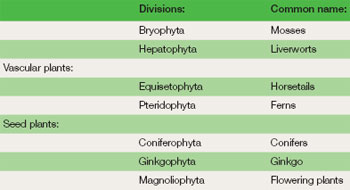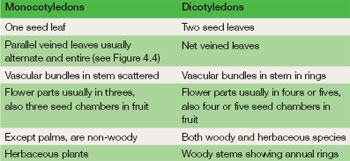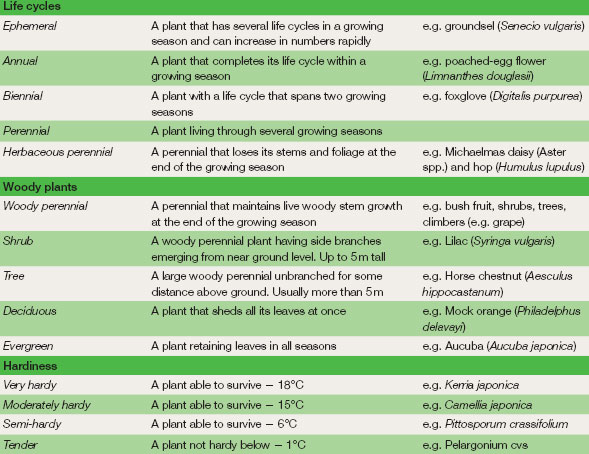Kingdom Plantae
Content
Plants The first major breakdown of the plant kingdom is into divisions (see Table 4.2). Divisions of the plant kingdom Mosses and liverworts: Over 25000 plant species which do not have a vascular system are included in the divisions Bryophyta and Hepatophyta. They have distinctive vegetative and sexual reproductive structures, the latter producing spores that require damp conditions for survival. Many from both divisions are pioneer plants that play an important part in the early stages of soil formation. The low spreading carpets of vegetation also present a weed problem on the
Ferns and horsetails in the divisions Pteridophyta and Equisetophyta, have identifiable leaf, stem and root organs, but produce spores rather than seeds from the sexual reproduction process. Many species of ferns, e.g. maidenhair fern (Adiantum cuniatum), and some tropical horsetails, are grown for decorative purposes, but the common horsetail (Equisetum arvense), and bracken (Pteris aquilina) that spread by underground rhizomes are difficult weeds to control. Seed-producing plants (Super-division – Spermatophyta) contain the most highly evolved and structurally complex plants. There are species adapted to most habitats and extremes of environment. Sexual reproduction produces a seed, which is a small, embryo plant contained within a protective layer. Angiosperms and gymnosperms The subdivision into class brings about the gymnospermae, mostly consisting of trees and shrubs, and the angiospermae representing the greatest diversity of plants with adaptations for the majority of habitats. Structurally, the gymnosperms have much simpler xylem vessels than the more complex system in the angiosperms, and flowers are unisexual producing naked seeds. The angiosperms usually have hermaphrodite flowers, which produce complex seeds, inside a protective fruit.
Flowering plants (Division – Magnoliophyta) have a flower structure for sexual reproduction producing seeds protected by fruits. This characteristic structure is used as the basis of their classification. There are estimated to be some 25000 species, occupying a very wide range of habitats. Many in the division are important to horticulture, both as crop plants and weeds. This division is split into two main classes; the Liliopsida formerly the Monocotyledonae and generally known as the monocotyledons, and the Magnoliopsida, the dicotyledons. The main differences are given in Table 4.3.
Dicotyledons has many more families significant to horticulture, including Magnoliaceae, the magnolias; Caprifoliaceae, the honeysuckles; Cactaceae, the cactuses; Malvaceae, the mallows; Ranunculaceae, the buttercups; Theaceae, the teas; Lauraceae, the laurels; Betulaceae, the birches; Fagaceae, the beeches; Solanaceae, the potatoes and tomato; Nymphaeaceae, the water lilies and Crassulaceae, the stonecrops. Four of the biggest and most economically important families in this class have had a change of name. Fabaceae (formerly the Leguminosae), the pea and bean family, have five-petalled asymmetric or zygomorphic (having only one plane of symmetry) flowers, which develop into long pods (legumes) containing starchy seeds. The characteristic upturned umbrella-shaped flower head or umbel is found in the Apiaceae (formerly the Umbelliferae), the carrot family, and bears small white five-petalled flowers, which are wind-pollinated. The members of Asteraceae (formerly Compositae) have a characteristic flower head with many small florets making up the composite, regular (or actinomorphic) structure, e.g. chrysanthemum, groundsel. Members of the Brassicaceae (formerly Cruciferae) are characterized by their four-petal flower and contain the Brassica genus with a number of important crop plants such as cabbage, cauliflowers, swedes, Brussels sprouts, as well as the wallflower (Cheiranthus cheiri). Most of the brassicas have a biennial growth habit producing vegetative growth in the first season, and flowers in the second, usually in response to a cold stimulus (see vernalization). A number of weed species are found in this family, including shepherd’s purse (Capsella bursapastoris), which is an annual. Many important genera, e.g. apples (Malus), pear (Pyrus) and rose (Rosa), are found within the Rosaceae family, which generally produces succulent fruit from a flower with five petals and often many male and female organs. Many species within this family display a perennial growth habit (see Table 4.4).
|
|||||||||||||||||||||||||||||||||||











